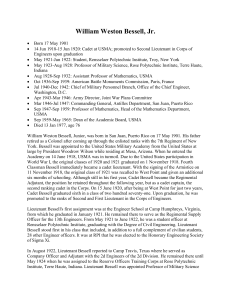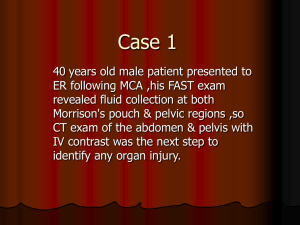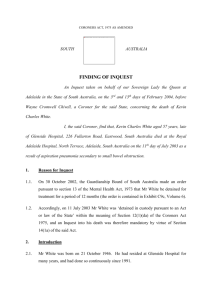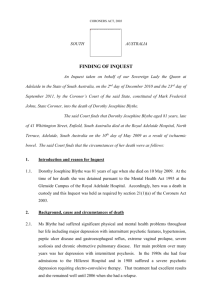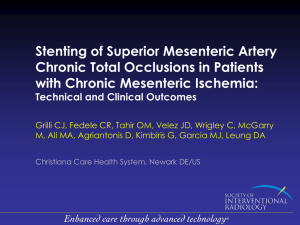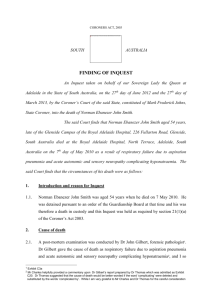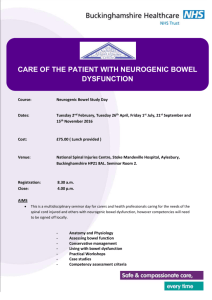BALNAVES Craig Henri
advertisement
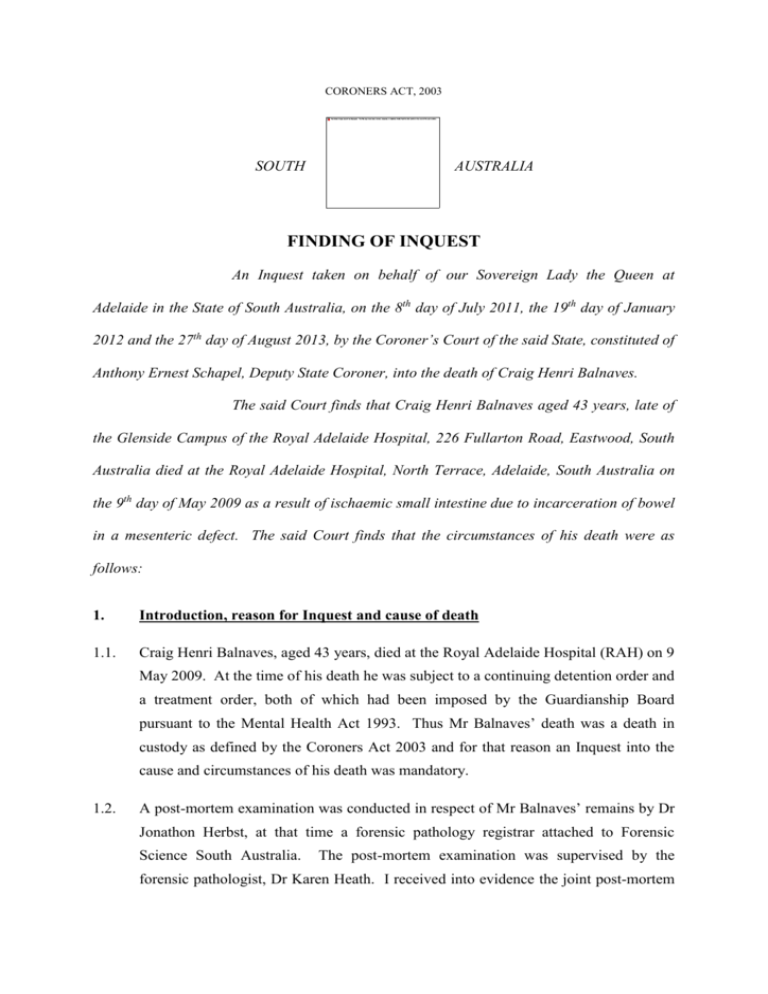
CORONERS ACT, 2003 SOUTH AUSTRALIA FINDING OF INQUEST An Inquest taken on behalf of our Sovereign Lady the Queen at Adelaide in the State of South Australia, on the 8th day of July 2011, the 19th day of January 2012 and the 27th day of August 2013, by the Coroner’s Court of the said State, constituted of Anthony Ernest Schapel, Deputy State Coroner, into the death of Craig Henri Balnaves. The said Court finds that Craig Henri Balnaves aged 43 years, late of the Glenside Campus of the Royal Adelaide Hospital, 226 Fullarton Road, Eastwood, South Australia died at the Royal Adelaide Hospital, North Terrace, Adelaide, South Australia on the 9th day of May 2009 as a result of ischaemic small intestine due to incarceration of bowel in a mesenteric defect. The said Court finds that the circumstances of his death were as follows: 1. Introduction, reason for Inquest and cause of death 1.1. Craig Henri Balnaves, aged 43 years, died at the Royal Adelaide Hospital (RAH) on 9 May 2009. At the time of his death he was subject to a continuing detention order and a treatment order, both of which had been imposed by the Guardianship Board pursuant to the Mental Health Act 1993. Thus Mr Balnaves’ death was a death in custody as defined by the Coroners Act 2003 and for that reason an Inquest into the cause and circumstances of his death was mandatory. 1.2. A post-mortem examination was conducted in respect of Mr Balnaves’ remains by Dr Jonathon Herbst, at that time a forensic pathology registrar attached to Forensic Science South Australia. The post-mortem examination was supervised by the forensic pathologist, Dr Karen Heath. I received into evidence the joint post-mortem 2 report of Drs Herbst and Heath which was verified by the affidavit of Dr Heath 1. The cause of Mr Balnaves’ death as expressed in the post-mortem report is ischaemic small intestine due to incarceration of bowel in a mesenteric defect. I find that to have been the cause of Mr Balnaves’ death. The report explains that Mr Balnaves had a mesenteric defect that is usually congenital in origin. The mesentery serves as an anchoring point of the bowel and contains the major blood vessels that supply that organ. The mesentery is usually situated flat against the peritoneum. However, in Mr Balnaves’ case there was a defect in the mesentery and this served as a window into which the intestine passed, became trapped and could not free itself. As the intestine passes through and becomes trapped, its blood supply becomes compromised. This may result in swelling which would render it all the more difficult for the intestine to become free and to pass back through the opening or defect. The compromise of blood supply can progress to infarction which can result in copious quantities of blood and fluid being released. This massive loss of blood and fluid results in shock and cardiovascular collapse. 1.3. Mr Balnaves place of detention was the Glenside Hospital. In this Inquest the Court examined the issue as to whether Mr Balnaves’ medical management at Glenside prior to his death had been appropriate, and in particular whether Mr Balnaves had been at any clinical disadvantage due to the nature of his detention. 1.4. The circumstances of Mr Balnaves’ death have been examined by an independent general and upper gastrointestinal surgeon, Dr Justin Bessell. Dr Bessell furnished the Court with two reports2. I deal with Dr Bessell’s opinions as to the appropriateness of Mr Balnaves’ clinical management in due course, but for the moment it is as well to record what Dr Bessell says in respect of mesenteric disease generally. Dr Bessell states that a mesenteric defect of the kind under discussion is rare. Furthermore the condition of mesenteric ischaemia, which Dr Bessell describes as an insidious clinical condition, is notoriously difficult to diagnose even following investigation by specialists in a tertiary hospital environment. While maintenance of a high index of suspicion is taught to trainee surgeons, the same could not be expected of nursing staff or general duties medical staff. Classically the clinical symptoms are out of proportion to the signs, and by the time the condition is diagnosed it is usually advanced and the patient is commonly unsalvageable, even in an operating theatre. The condition has a high mortality rate quoted as 59% to 73%. Dr Bessell also 1 2 Exhibits C3 and C3a Exhibits C21a and C21b 3 observes that in Mr Balnaves’ particular case the mesenteric ischaemia was atypically caused by an internal hernia, in this case in the form of a congenital mesenteric defect. In his entire surgical practice he could only recall witnessing one such example, and in any event such a defect would characteristically usually be diagnosed on the operating table or post-mortem as in this case. Such a condition he suggests was: 'Well beyond any reasonable diagnostic expectation of medical and nursing staff charged with Mr Balnaves’ care.' 2. Background 2.1. By way of background Mr Balnaves suffered from a number of mental illnesses, the principal of which was treatment resistant schizophrenia. He had been an inpatient at Glenside Hospital since 2000. He had an unremarkable medical history as distinct from psychiatric history. Nevertheless, between January and April 2009 it appears that Mr Balnaves had some abdominal complaints. However, the clinical record reveals that following symptomatic treatment of these intestinal complaints no residual concern was raised by the deceased. 2.2. More acutely, on the late evening of 8 May 2009 Mr Balnaves complained of abdominal pain for which he was initially given some Gastrogel, which is an antacid, and then Panadol. He returned to bed and slept until the morning. After waking at approximately 7:30am Mr Balnaves on a number of occasions complained of stomach pain and finally stated that he wished to go to hospital. An examination by the duty doctor at Glenside revealed that Mr Balnaves had a rigid abdomen. A provisional diagnosis of acute abdomen was made and Mr Balnaves was conveyed by taxi to the RAH where he collapsed and died that day from the cause of death that I have identified. 3. Issues arising 3.1. Shortly before this Inquest was commenced the Court received correspondence from Ms Vanessa Balnaves who is the sister of the deceased 3. In her letter Ms Balnaves expressed a number of concerns about Mr Balnaves’ management. At the time the letter was received, only the first report of Dr Bessell was available. In that report4 Dr Bessell had not expressed any adverse opinion concerning Mr Balnaves’ management at Glenside nor at the RAH except in relation to the manner of his conveyance 3 4 Exhibit C20b Exhibit C21a 4 between the two hospitals. Having regard to the matters raised by Ms Balnaves in her letter I requested Dr Bessell to furnish a further report addressing two of the relevant specific concerns raised by Ms Balnaves in her letter. Dr Bessell furnished a further report5. 3.2. In his two reports Dr Bessell expresses a number of opinions which I accept in their entirety. Those opinions can be summarised as follows: Although Mr Balnaves did have a serious intra-abdominal issue, there was little clinical evidence overnight to suggest that Mr Balnaves had been suffering from anything other than a common stomach ache; There was no clinical evidence to suggest that Glenside Hospital staff should have had their clinical suspicion aroused that there was a serious intra-abdominal problem. In this regard Dr Bessell points out that overnight Mr Balnaves was provided with simple symptomatic treatments and he thereafter slept in apparent comfort with no cause for concern evident; It is evident that on the morning of 9 May 2009 staff became increasingly and appropriately concerned about the persistence of Mr Balnaves’ discomfort; At 12:10pm the Glenside Hospital doctor correctly diagnosed Mr Balnaves as having a serious intra-abdominal illness and acted correctly in immediately arranging transfer to the RAH; While it would have been preferable for Mr Balnaves to have been conveyed to the RAH by way of ambulance and not taxi, the mode of transfer had no bearing on the outcome. I would add here that Mr Balnaves’ cardiac arrest did not occur until he reached the RAH, not en route, and so the mode of conveyance is of no material consequence; The non-specific nature of presentation of mesenteric ischaemia is well known to result in delayed diagnosis and that this is responsible for poor reported outcomes. Investigative techniques are quite limited in assisting with this diagnosis which is usually prompted by the index of suspicion of an appropriately trained specialist; Dr Bessell did not believe that overnight there would have been any outward signs of Mr Balnaves’ underlying condition, but that in the morning the abdominal signs were correctly interpreted; 5 Exhibit C21b 5 If Mr Balnaves had been transferred to hospital overnight, and correctly diagnosed and treated by the receiving hospital, Mr Balnaves’ life may have been saved. However, he opines that it is inappropriate to suspect every individual with a common stomach ache to be at risk of an acute abdominal emergency and there is no certainty that the receiving hospital would in any case have correctly diagnosed the condition any earlier; If Mr Balnaves’ life had been saved by way of extensive surgery and prolonged ICU care, given the large volume of bowel trapped in his congenital hernia, the resection would have rendered Mr Balnaves as ‘an intestinal cripple’ and have subjugated him to a life on permanent intravenous feeding within a tertiary care institution; That if Mr Balnaves’ abdominal symptoms between January and April 2009 had been reflective the presence of rare mesenteric defect, he would have expected him to have manifested symptoms or signs of intermittent small bowel obstruction evincing a clinical scenario that would have been unmistakable at that time. Mr Balnaves did not present such a clinical picture and so Dr Bessell was of the opinion that the symptoms reported by Mr Balnaves were not at all suggestive of intermittent bowel obstruction, but were consistent with reflux; A CT scan at the time of previous self-reporting of symptoms may have diagnosed Mr Balnaves’ condition, but having regard to the relatively non-specific abdominal symptoms that resolved fairly rapidly with symptomatic measures, it would not have been considered appropriate to have referred him for a CT scan. Although a CT scan may have diagnosed and revealed a mesenteric defect, this would only be the case if the bowel happened to be trapped at that moment in time. Dr Bessell concludes his second report with the following: 'I hope this provides answers to the questions sought, and may provide some measure of comfort to his family. I believe pertaining to the issues I have been asked to comment on, Mr. Balnaves was cared for at a standard of care the community would expect for themselves and their relatives.' 6 The Court accepts Dr Bessell’s opinions in that regard and has nothing further to add. 6 Exhibit C21b 6 4. Recommendations 4.1. The Court does not see any need to make any recommendations in relation to this matter. Key Words: Death in Custody; Natural Causes In witness whereof the said Coroner has hereunto set and subscribed his hand and Seal the 27th day of August, 2013. Deputy State Coroner Inquest Number 24/2011 (0768/2009)
